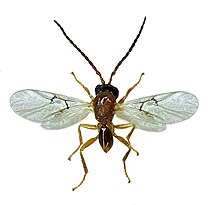Biorhiza pallida
| Biorhiza pallida | |
|---|---|

| |
| Male Biorhiza pallida. The wings would be folded over the abdomen in life | |
| Scientific classification | |
| Kingdom: | |
| Phylum: | |
| Class: | |
| Order: | |
| Family: | |
| Genus: | |
| Species: | B.pallida
|
| Binomial name | |
| Biorhiza pallida | |
Biorhiza pallida is a
Description
Biorhiza pallida has a complex life cycle involving an agamic female that reproduces by parthenogenesis without a male during the summer, and a winter/spring generation of adults where individuals are either male or female. These mate and produce fertilised eggs.
The wingless agamic wasp is between 4.8 and 6.3 millimetres (0.19 and 0.25 in) long. The head is golden brown with mid-brown eyes and orange
Male and female wasps that develop in the summer generation are smaller with a length between 2 and 3.5 mm (0.08 and 0.14 in). The head, thorax and gaster are golden brown and translucent. The clear wings have dark veins and pale brown hairs. The eyes are large and dark in the case of the female and pale in the male. The other main difference between the sexes is the gaster, which is deep and narrow in the male and broad and tipped with an ovipositor in the female.[2]
Life cycle

The winter-hatching generation of agamic females climb up the
Ecology
As well as providing food and protection to the wasp larvae, the galls provide shelter for several inquiline species of gall wasp including Synergus gallaepomiformis and Synergus umbraculus. These share the tissues that provide food for the wasp larvae. About twenty other species of gall wasps are hyperparasites and live inside the gall and parasitise the rightful owners, the Biorhiza pallida larvae.[2]
References
- PMID 11737276.)
{{cite journal}}: CS1 maint: numeric names: authors list (link - ^ a b c "Biorhiza pallida". Parasitica. Archived from the original on 2013-08-24. Retrieved 2012-12-23.
- ^ ISBN 0-7513-0048-9.
- ^ "Gall wasp". Encyclopædia Britannica. Retrieved 2012-12-23.
